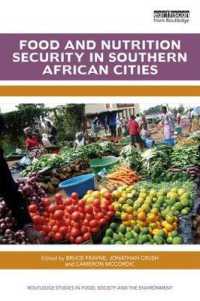- ホーム
- > 洋書
- > 英文書
- > Science / Mathematics
Full Description
Machine Learning in Geohazard Risk Prediction and Assessment: From Microscale Analysis to Regional Mapping presents an overview of the most recent developments in machine learning techniques that have reshaped our understanding of geo-materials and management protocols of geo-risk. The book covers a broad category of research on machine-learning techniques that can be applied, from microscopic modeling to constitutive modeling, to physics-based numerical modeling, to regional susceptibility mapping. This is a good reference for researchers, academicians, graduate and undergraduate students, professionals, and practitioners in the field of geotechnical engineering and applied geology.
Contents
Part 1: Machine learning methods and connections between different parts.
1. Machine learning methods
2. Connections between studies across different scales
3. Summary and outlook
Part 2: Machine learning in microscopic modelling of geo-materials.
4. Machine-learning-enabled discrete element method
5. Machine learning in micromechanics based virtual laboratory testing
6. Integrating X-ray CT and machine learning for better understanding of granular materials
7. Summary and outlook
Part 3: Machine learning in constitutive modelling of geo-materials.
8. Thermodynamics-driven deep neural network as constitutive equations
9. Deep active learning for constitutive modelling of granular materials
10. Summary and outlook
Part 4: Machine learning in design of geo-structures.
11. Deep learning for surrogate modelling for geotechnical risk analysis
12. Deep learning for geotechnical optimization of designs
13. Deep learning for time series forecasting in geotechnical engineering
14. Summary and outlook
Part 5: Machine learning in geo-risk susceptibility mapping for regions of various sizes.
15. Deep learning and ensemble modeling of debris flows, mud flows and rockfalls.
16. Integrating machine learning and physical-based models in landslide susceptibility and hazard mapping.
17. Explainable AI (XAI) in landslide susceptibility, hazard, vulnerability and risk assessment.
18. New approaches for data collection for susceptibility mapping
19. Summary and outlook








